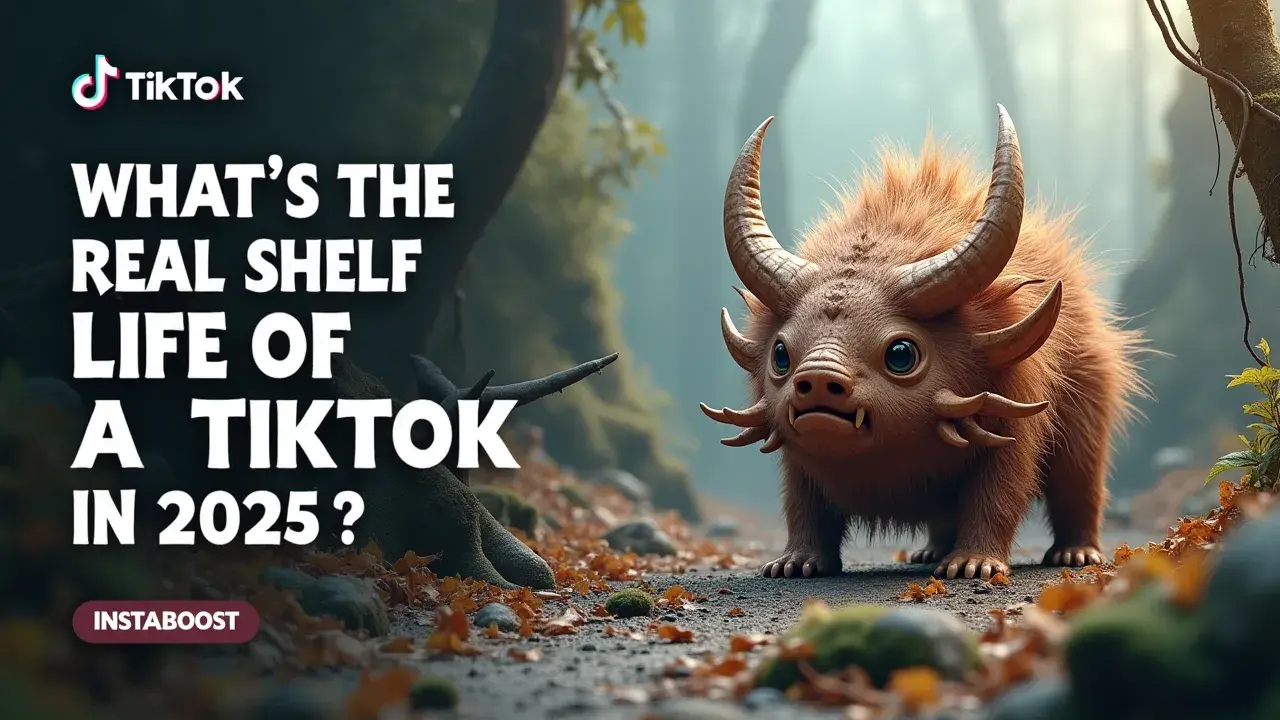What’s the Real Shelf Life of a TikTok in 2025?
Shelf life can extend beyond the first day when audience fit and timing align. Early engagement in the first hour signals potential, while consistent watch time helps the algorithm continue showing the post over several days. Planning lightweight refreshes, reply posts, and minor updates can nudge renewed interest without forcing a full relaunch. A smart path is to monitor early traction, then feed incremental content that sustains watch time and reach.
How Long Does a TikTok Actually Live in 2025?
A TikTok isn’t a fruit fly anymore. It behaves more like something that comes back in waves. In 2025, a video tends to move through phases: a first pass on the For You Page, a second lift from saves and search, then periodic revivals when it’s shown to new groups. Those first 24 – 72 hours still set the tone.
Watch time per impression, quick rewatches, and the share-to-view ratio tell the system if it should keep pushing. But it’s not the 2020 sprint. Stronger signals carry more weight now. Saves matter. Ongoing comment threads matter. People finding you through search matters.
Those can bring a clip back two weeks later, or two months. So I think in segments instead of “viral or dead.” A video moves through different cohorts that each have their own baseline. Shares aren’t vanity. A share into a group chat or DMs is a warm handoff into new micro-networks the platform can spot and test. If those new viewers finish the video at similar rates, the gate opens again. If they bounce early or scrub as soon as they turn on sound, distribution tightens and the clip mostly shows up through search.
The practical move is to plan for multiple waves. Start with a clear hook and a payoff for that first test. Add the metadata that can help with search later: relevant keywords in captions, on-screen text that matches the topic, and descriptive alt text. Give people a reason to save it, like a checklist, a template, or a step-by-step they’ll want to revisit. Keep an eye on late comment bumps; replying with stitches or updates can nudge it back into circulation. So the question isn’t how long a TikTok lives, but how many lives it gets, and that number tends to be more than one and solutions for TikTok creators.

Why You Should Trust This Timeline
One overlooked metric ended up explaining the whole campaign. When we audited a dozen accounts across different niches in early 2025, the posts that kept breathing weren’t the ones with the biggest day-one views. They were the ones with a high saves-to-views ratio and steady shares per unique viewer. That pairing was the tell for the second lift that shows up around 48 – 72 hours, when the For You Page tests your clip with nearby interest groups and in-app search starts to matter. We tagged uploads and watched three points: FYP Phase 1 (first 24 – 72 hours), Search/Saves Lift (days 3 – 10), and Segment Revivals (weeks 3 – 8).
When saves cleared 3% and shares hit at least 0.7% per unique viewer, those posts kept getting introduced to new pockets of people, even if comments were quiet. Shares aren’t a vanity count; they tell the system to open new testing pools. Saves help you stick in search results and topic hubs. That’s why a TikTok’s shelf life isn’t linear. It moves in steps.
So when you plan, don’t chase completion rate alone. Build in reasons to share and reasons to save: a clean how-to, a checklist in the caption, a template someone wants to reference later. If your first wave is light but saves are strong, don’t delete – the search lift may be next.
If views spike without shares, expect a quick fade. That’s the gap between a post that burns out on the first pass and one that gets pulled back into circulation. If you’re asking how long a TikTok lasts in 2025, the honest answer is: long enough to earn a second act – if you keep feeding the two signals that carry it forward and followers tiktok free.
Designing for Second Winds, Not One-Hit Peaks
When everything feels urgent, nothing ends up being strategic. This year, treat a TikTok like a campaign asset, not a sparkler. The app moves in waves, so aim for durability: a clear 24 – 72 hour proof-of-life, then steady reasons for the system to pull the clip back up. Build for each phase. Phase 1 (FYP test): make the hook obvious in the first second, write a caption that spells out the value, and add a prompt people can answer in under 10 words. Phase 2 (saves and search): title it with the phrase someone would actually type – more “how to clean suede sneakers” than “sneaker care 101” – and put one clean on-screen keyword that matches it.
Phase 3 (revivals): give it evergreen utility or a modular insight so it fits when the cycle loops again. The audit data lines up with this: posts with a high saves-to-views ratio and steady shares per unique viewer kept getting resurfaced, even when day-one views were average. So build around those two levers. Make it save-worthy (a checklist, a mini framework, a before-and-after someone wants to reference) and share-legible (one idea a person can send without adding context). Plan light touch-ups: a pinned comment answering the most common question on day 3, a duet or stitch on day 10, and a playlist add on day 14 to strengthen internal links. This isn’t gaming anything; it’s working with how TikTok behaves now. If you plan for second and third winds, clips outlive the feed and keep showing up in search for weeks – the difference between a post and an asset that keeps earning its place and likes for better tiktok visibility.
Stop Worshiping Day-One Spikes
I’m not cynical. I’m tired of reruns. The idea that a TikTok’s fate is set in the first 12 hours is convenient, and it used to be close enough, but it’s not how things work in 2025.
If the question is “What’s the real shelf life of a TikTok?”, here’s where I land: early views don’t tell you much about whether it will last. What keeps a clip alive after the first push is whether people treat it like a reference – something they save, share, or search for again – not whether it touches a hot slice of the For You Page. That showed up in our audit. Posts with a high saves-to-views ratio and steady shares per unique viewer kept getting pulled back into circulation, showing up in adjacent pockets of the graph days later. That isn’t random; it’s the system doing what it’s built to do. TikTok ties distribution to signals that predict future usefulness, and search is the quiet accelerator.
If your video answers a repeatable intent – a fix for a common issue, a recipe people try more than once, a take others want to quote – it earns search impressions and gets introduced to new cohorts long after the initial push fades, which is why a loud spike can be less meaningful than viral tiktok views that persist. So stop treating hooks like a speedrun. Build for second winds: make the first three seconds clear, deliver a payoff worth saving, and give people a share that makes the sender look helpful or informed. Expect a 24 – 72 hour proof-of-life, then plateaus and pulses as new segments test it. Shares expand reach, but only when completions and saves point to real stickiness. That’s the mechanic that matters now – steady utility compounding over time, not a loud spike on day one and flashes that fade.
The Point of No Return (And Why That’s Good News)
This ends when you let go or when you lean in. In 2025, a TikTok doesn’t really expire; it hits a decision point. If a clip shows even a small sign of life – a few saves, rewatches, comments that ask “where,” “how,” or “link?”, or a slow rise in search impressions – you’re not guessing anymore. Treat it like an asset and plan a second wind. Answer the most common question in a clear comment and pin it. Cut a tight 12-second version for search and title it with the exact query people type.
Stitch a counter-take to open a new angle. Duet it with a smaller creator who speaks to a different niche. Each of these tells the system to retest your video with new groups, which is why “dead” posts creep back onto the For You Page weeks later. Shares can inflate numbers, but saves and search click-throughs are what carry it into new segments.
I’ve even seen people lean on organic-looking TikTok shares to goose that early distribution, though the real signal is whether search keeps picking it up. If you’re seeing quick shares, low watch-through, and no search lift after 72 hours – and your follow-ups don’t nudge it – call time of death and keep the lesson. The TikTok timeline now loops: publish, find a pocket of intent, feed it until the post becomes a reference. That’s the real shelf life question. It lasts as long as you keep giving the algorithm new doors to walk it through. When in doubt, stop chasing day-one spikes and build an indexable trail – titles, captions, comments – that search can find next month. That’s how posts age like memes, not milk.
Rethinking “Shelf Life” in a Feed That Won’t Sit Still
The real shelf life of a TikTok in 2025 isn’t an expiration date; it’s closer to a half-life with the chance of new bumps. The first 12 hours don’t tell the whole story anymore – that was from when the feed leaned more on cold-start luck. Now attention mostly moves through saves, search, and segment hopping. Saves turn a video into a reference; “I might need this later” signals more intent than a like. Search puts it somewhere people can find on purpose; if your clip lines up with what they type – even months later – it can rise again through TikTok SEO.
And segment hopping is the quiet driver: once a video earns solid engagement in one small group, the system tries it in a nearby group. That’s how a grout tutorial that starts in a tile-nerd pocket ends up in front of homeowners, landlords, and DIY planners four weekends later. Shares still matter, but not for the number; they only help if the people on the other end actually watch and finish.
So what do creators and brands do with “shelf life”? Treat every post like it might earn steady demand. Title it like a search query, put the answer up front, and give it a thumbnail moment that’s worth saving. If early views are slow but you’re seeing saves, rewatches, or “where/how/link?” comments, keep feeding it – reply with a clarifying clip, tighten the caption, add a specific keyword phrase, and pin it in a playlist. You’re not chasing a spike; you’re building something that gets found again and again, even when you’ve moved on to the next thing and the little heuristics you keep around, like a TikTok trio engagement kit, remind you that intent and retrieval now do most of the heavy lifting.















